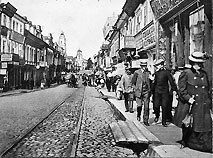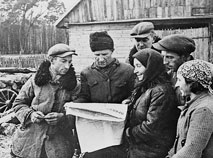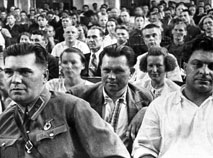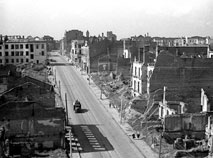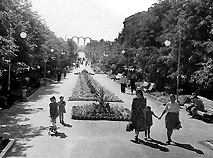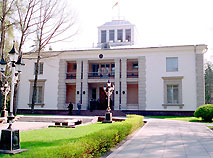Belarus history
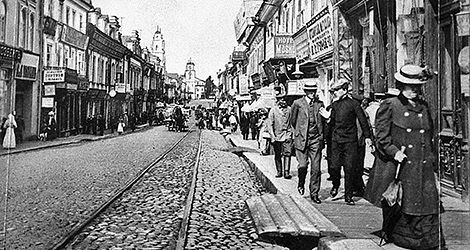
Minsk in the early 20th century
Gubernatorskaya Street
The history of Belarus dates back to the Stone Age. This timeline of Belarus shows how Belarusian historical events have shaped the country today.
Belarus in the Stone Age (100,000-3,000 BC)
The first signs of settlements in ancient Belarus date back some 250,000 BC. The Stone Age (Lower-Early Middle Paleolithic) site in the village of Ogovo (Ivanovo District, Brest Oblast) is considered to be the oldest one in the Belarusian lands and one of the oldest in Eastern Europe.
The ancient settlements have been discovered in the Gomel oblast. Sites discovered from the Palaeolithic period in the village of Yurovichi (Kalinkovichi area) existed approximately 26 000 years ago. Sites discovered in the village of Berdysh (Chechersk area) date back 23,000-24,000 years. Ancient cultural relics have also been discovered in the Mogilev, Grodno and Minsk oblasts.
Belarus in the Bronze Age (8th-6th Century BC)
Artefacts dating back to the Bronze Age have been found in settlements across Belarus.
Belarus in the Iron Age and Middle Ages (8/7th Century BC-8th Century AD)
At the beginning of the Iron Age there were 3 main settlements in Belarus around the major river basins of the Dneiper, Dvina, and Pripyat rivers.
-
Milogradskaya culture
-
Pomorskiy culture
-
Dneiper-Dvinskiy culture (ancestors of the Letts)
First states to be formed on Belarusian territory (7th-13th Century AD)
Belarus colonization by the Slavs began in the early centuries AD. Over the next few centuries they had settled over the entire region, replacing the earlier Baltic culture.
In the 6th to 9th centuries East Slavs formed the first political associations – the unions of tribes.
The 9th century gives us the first recorded accounts of Polotsk and the Polotsk Duchy in the territory of modern Vitebsk and the northern part of the Minsk oblasts. It remained the dominating force in the region until the 13th century.
The Grand Duchy of Lithuania, Rus and Samogotia (13th-16th Centuries)
The Grand Duchy of Lithuania, Rus and Samogotia was a powerful state spanning Belarus, Lithuania, the Kiev, Chernigov and Volyn areas of the Ukraine and western Russia from the Baltics to the Black Sea.
The Grand Duchy began its rise to power under the reign of Mindovg (Mindaugas) in the 13th century and only began to lose its authority after a number of wars in the 16th century.
In 1569 the Grand Duchy and the Kingdom of Poland signed the Union of Lublin: on equal terms the Duchy and the Crown united in a federative state – Rzecz Pospolita. It signified the start of a new chapter in Belarusian history.
Rzecz Pospolita (1569-1795)
This was a particularly turbulent time in Belarusian history. The state was drawn into wars in Europe and with Russia including:
-
1654-1667 – war with Russia
-
1700-1721 – North War (Sweden and Russia)
Rzecz Pospolita led to long wars which weakened the state, and it lost its independence. In 1772 the western provinces of Belarus were annexed to the Russian Empire and in 1795 Rcecz Pospolitsa was divided between Russia, Austria and Prussia.
The Russian Empire (1772-1917)
As a result of the division of Rzecz Pospolita into three parts, Belarus land became part of the Russian Empire.
1794 to the First World War – a string of conflicts including:
-
Revolt under Tadeusz Kostushko’s leadership (1794)
-
Napoleonic invasion of Russia (1812)
-
Polish Revolt (1830 – 1831)
-
Great Rebellion, headed by Kastus Kalinovski (1863-1864)
In the 1880s the revolutionary organisation Gomon was established by Belarusian students in Saint Petersburg. This was the precursor to the first Belarusian national political party Gromada, formed in 1903.
In 1906 the Stolypin agrarian reform began. Mass displacement of the peasant classes (from 1906 – 1916) saw more than 33,000 move from Belarusian territory to Siberia.
World War 1 (1914-1918)
1915 - 1916 – Belarusian territory was the scene of bloody battles between German and Russian forces.
3rd March 1918 – signing of the Treaty of Brest-Litovsk, marking Belarus’ exit from World War One. The Belarusian territories were occupied by German forces until 1918.
Revolution in Russia (1917-1919)
March 1917 – Revolution in Russia resulted in the abdication of Tsar Nicholas II.
November 1917 – Bolsheviks seized power in Russia.
March 1918 – the Belarusian People’s Republic declared independence. This lasted until the German withdrawal later that year.
1 January 1919– creation of the Belarusian Soviet Socialist Republic.
Russo-Polish War (1919-1921)
1921 – the Riga Peace Treaty resulted in the partitioning of Belarus between the Belarusian Soviet Socialist Republic and Poland.
1921-1941
1921-1928 – New Economic Policy (NEP) introduced across Belarus.
1921-1930s – the Polish part of Belarus subjected to Polonisation.
1922 – Belarusian SSR became a part of the Union of the Soviet Socialist Republics (USSR).
World War 2
17 September 1939 – two weeks after the outbreak of World War Two, the Red Army moved into West Belarus.
June 1941 – the start of the Great Patriotic War in Belarus.
June-July 1941 – resistance in Brest against German invaders lasted 6 weeks. The city was occupied until Soviet troops liberated it in 1944.
September 1941 – Belarus fully occupied by the German army. Invaders start to establish so-called “new order” based on terror.
June 1941 – Germans established Minsk ghetto and moved Belarusian, German and Czech Jews in. Mass executions of prisoners from the Minsk ghetto in Tuchinki occurred until October 1943.
End of 1941 – Partisan movement begins in Belarus and becomes the biggest movement in Europe before 1944.
1943 – German General Commissioner Kube assassinated in Minsk.
End of June - July 1944 – Operation Bagration saw the liberation of Belarusian SSR by the Red Army from fascist invaders. On 3 July, Minsk is liberated.
February 1945 – Yalta conference expelled Poles from the western region of Belarus. The region was officially recognised as part of the Belarusian Soviet Socialist Republic.
1945 - 1994
May 1945 – The Great Patriotic War of the Soviet people against fascist aggressors ended.
1945 – Belarus becomes a member of the Organisation of the Incorporated Nations (United Nations)
1954 – Belarus enters the United Nations Educational, Scientific and Cultural Organisation (UNESCO)
April 1986 – Chernobyl Nuclear reactor disaster pollutes large areas of Belarusian territories.
27 July 1990 – The Supreme Council of the Belarusian SSR adopted the Declaration of State Sovereignty of the Belarusian Soviet Socialist Republic.
25 August 1991 – The Declaration of State Sovereignty of the Belarusian Soviet Socialist Republic was given the status of constitutional law. The move virtually proclaimed the independence of the Belarusian SSR.
19 September 1991 – The name of the state was adopted – the Republic of Belarus.
8 December 1991 – The dissolution of the Soviet Union was officially announced at a meeting of the heads of state of Russia, Ukraine and Belarus in Viskuli, Brest Oblast.
15 March 1994 – Belarus' new Constitution was adopted by the Supreme Council of the Republic of Belarus, with presidency introduced.
1994 – The first presidential election in the independent republic was held. Aleksandr Lukashenko became the first President of the Republic of Belarus. The head of state was inaugurated on 20 June 1994.
14 May 1995 – Parliamentary elections and the first referendum in the history of independent Belarus were held. The referendum took care of giving the Russian language an equal status with the Belarusian language, establishment of a new national flag and a new national emblem of the Republic of Belarus, economic integration with the Russian Federation...
7 June 1995 – A Belarus President decree approved the new State Emblem and State Flag of the Republic of Belarus.
2 April 1996 – Presidents of Belarus and Russia Aleksandr Lukashenko and Boris Yeltsin signed the Treaty on establishing the Community of Belarus and Russia, and on April 2, 1997 the treaty on the Union of Belarus and the Russian Federation was signed. This date is celebrated as the Day of Unity of the Peoples of Belarus and Russia.
19-20 October 1996 – the 1st All-Belarusian People’s Congress was held. It became a strong social institution afterwards. The representatives from all over the country gathered to discuss the main tendencies of social and economic development in the country.
24 November 1996 – A referendum was held. Amendments and addenda were introduced to the Constitution of the Republic of Belarus to create a bicameral parliament, expand the powers of the President. The Independence Day was moved to 3 July – the day of Belarus’ liberation from the Nazi invaders during the Great Patriotic War.
8 December 1999 – the treaty to set up the Union State of Belarus and Russia was signed, an action program to implement the agreement was adopted.
10 October 2000 – Belarus, Kazakhstan, Kyrgyzstan, Russia, and Tajikistan signed the treaty on establishing the Eurasian Economic Community (EurAsEC).
27 November 2009 – The heads of state of Belarus, Kazakhstan, and Russia signed documents to create the Customs Union as from 1 January 2010.
18 November 2011 – The declaration on the Eurasian economic integration was adopted. The treaty signed by Belarus, Russia, and Kazakhstan to set up the Single Economic Space came into force on 1 January 2012.
22 July 2012 – the Belarusian satellite (BKA) designed to enable the remote sensing of the Earth was launched into outer space from the Baikonur space launch site.
29 May 2014 – The Eurasian Economic Union (EEU) treaty was signed by Belarus President Aleksandr Lukashenko, Russia President Vladimir Putin, and Kazakhstan President Nursultan Nazarbayev in Astana. The document took effect on 1 January 2015.







 print version
print version make home page
make home page add to bookmarks
add to bookmarks
